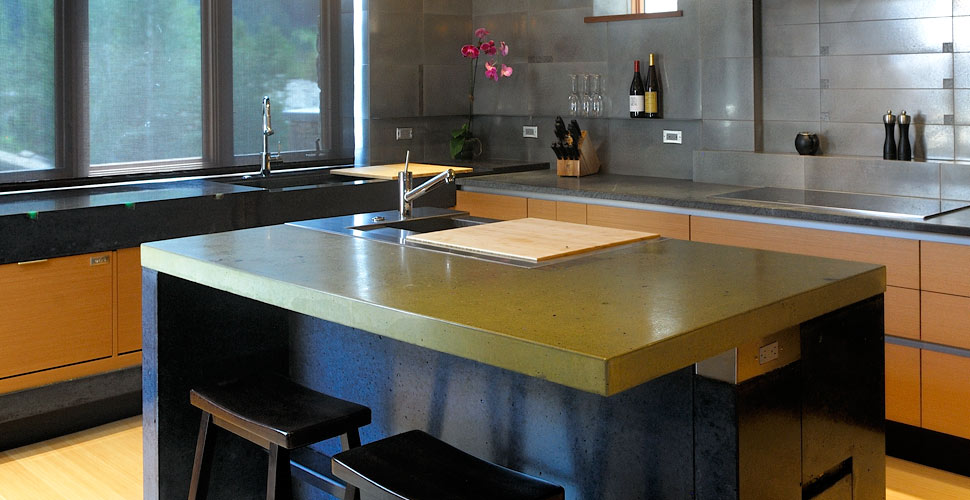Frequently asked DIY concrete countertops questions:

Q1: Why consider concrete as a material for interior applications, like my kitchen or bathroom counters?
Concrete is an extraordinary material that is practical, expressive, and aesthetic all at once. From a primal and formless slurry, you can transform it into virtually any shape that becomes a solid mass. The possibilities for creative expression are endless. You can grind, polish, stamp, or stain it. You can embed meaningful objects within it. Learn more about concrete.
Q2: I would love to make a concrete countertop as a do-it-yourself home improvement project, but can I afford it?
We’re glad you asked! Fu-Tung Cheng wrote the Concrete Countertops Made Simple Book and DVD Guide to help homeowners make their own concrete countertops that are affordable, green, and unique. With this latest book, Fu-Tung focuses on one specific project, breaking down the details in an approachable process and emphasizes this creative, do-it-yourself project as fun and affordable. The CHENG line of concrete countertop products combine the highest quality ingredients with convenient, pre-measured quantities making it possible to create your own concrete countertop—start to finish—for as little as $8/ square foot.
Q3: What kind of experience is required to make a concrete countertop?
A certain level of skill will make any do-it-yourself project easier, but with CHENG Concrete Countertop Products, we’ve made previous knowledge unnecessary, and the process DIY-friendly. We test our process and system of products with do-it-yourself (from novices to semi-pros) to insure they can successfully build beautiful counters particularly if they carefully follow the instructions in the Concrete Countertops Made Simple Book and DVD Guide.
Of course, practice always helps. Before taking on your entire kitchen or bathroom, you may want to start with a smaller project so that you get your “feet wet” and get to a comfort level with the materials. You can explore available instructional project drawings in our online store. We do recommend familiarizing yourself with the operation and safety precautions for the tools you will use throughout your project — this is always the most important preparation for any project: safety first!
Q4: How do I purchase the “CHENG Concrete Countertop Products” referred to in Fu-Tung’s books, Concrete Countertops and Concrete Countertops Made Simple?
All CHENG Concrete Countertop Products can be found at our Online Store, the most complete source for concrete countertops supplies including:
• CHENG Pro-Formula Concrete Countertop Mix
• Forming or mold-making materials
• Finishing Products
• Decorative Aggregates
• Shop Equipment, including concrete mixers and vibrators
• Concrete Project Drawings + Instructional Products
With our updated Pro-Formula Project Calculator, you can now order products in quantities required of the specifications of your precast concrete project.
CHENG Pro-Formula Concrete Countertop Mix is engineered for ease-of-use and to yield consistent, professional results with each project. Pro-Formula is a formulation of admixtures and pigments combined in pre-measured quantities and proportions which yield an ideal consistency for pouring and finishing (available in one or three cubic foot concrete countertop mixes).
NeoMix Original Concrete Countertop Products can be purchased as individual decorative concrete mix components. NeoMix Original Products refers to three separate components in our original mix system: Admixture, Water Reducer and Pigment. Each component is packaged separately and requires you to add them individually to a mixer. When combined with six 60-pound bags of premium sacked concrete, the mixture yields a three cubic foot concrete countertop mix.
Used by both building professionals and do-it-yourselfers, results from either Pro-Formula or NeoMix products are the same. Most customers and DIYs purchase Pro-Formula Concrete Countertop Mix for its simplicity and consistent results. However, some professionals prefer NeoMix Original Products for the ability to control the individual quantities of admixture, water reducer and pigment and to develop their own custom mix designs.
Q5: Fu-Tung Cheng’s Concrete Countertop books mostly explains how to make pre-cast concrete counters, but because of the size of my kitchen island countertop, I was considering pour-in-place. Do you consider pour-in-place countertops to be a bad idea?
The pour-in-place (or cast-in-place) method is covered in the last chapter of Concrete Countertops (Taunton Press, 2002) and Fu-Tung’s second book, Concrete at Home (Taunton Press, February 2005). The two main limitations to the pour-in-place methodology are the: a.) lack of detail made possible with top troweling, and b.) the difficulty in creating elevation changes (which limits design possibilities). Even if you wish to grind and polish-in-place after the concrete piece has cured, it is inherently more difficult to do so because the countertop surface is not as flat as when it is precast; therefore, achieving a level, pristine surface will require a significant amount of polishing down of the surface, not to mention patience and a more professional skill set.
